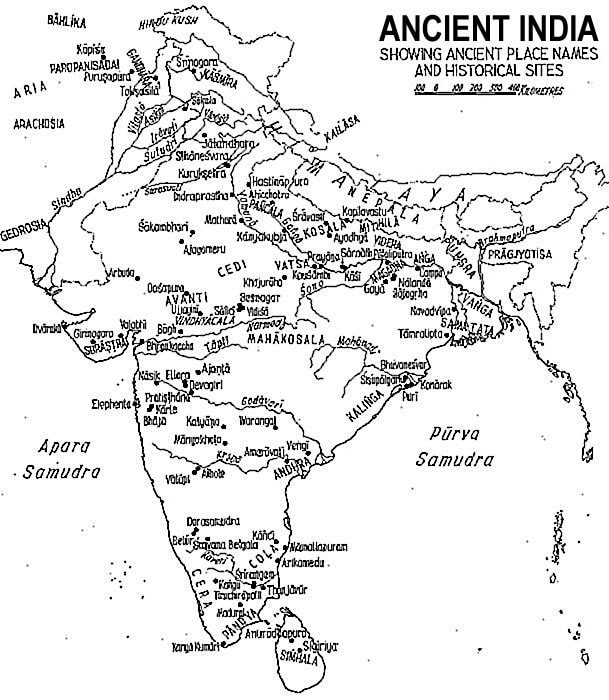Indian History Chronology: Indian History is a topic of interest to many including foreigners because of the cultures and civilizations existed in this sub-continent. History of India can be studied under political, cultural, religious or economic heads.
Indian History Chronology
Chronologically, Indian History can be classified into three periods – Ancient India, Medieval India and Modern India.
Ancient India (Pre-historic to AD 700)
There were activities of proto-humans (Homo erectus) in the Indian subcontinent 20 lakh years (2 million years) ago, and of Homo sapiens since 70,000 BC. But they were gathers/hunters.
The first inhabitants of Indian subcontinent might have been tribals like Nagas (North-East), Santhals (East-India), Bhils (Central India), Gonds (Central India), Todas (South India) etc. Most of them are speakers of the Austric, pre-Dravidian languages, such as Munda and Gondvi. Dravidians and Aryans are believed to be immigrants who came later to the sub-continent.
Ancient India can be studied under other heads like Paleolithic, Mesolithic, Neolithic and Chalcolithic period – based on the type of stone/ metal tools people used.
Paleolithic Period (2 million BC – 10,000 BC)
- Fire
- Tools made up of lime stone
- Ostrich Eggs
- Important Paleolithic sites: Bhimbetka (M.P), Hunsgi, Kurnool Caves, Narmada Valley (Hathnora, M.P), Kaladgi Basin
Mesolithic Period (10,000 BC – 8,000 BC)
- Major Climatic Change happened
- Domestication of animals ie Cattle rearing started
- Microliths found at Brahmagiri (Mysore), Narmada, Vindya, Gujarat
Neolithic Period (8000 BC – 4,000 BC)
- Agriculture Started
- Wheel discovered
- Inamgaon = An early village
- Important Neolithic Sites : Burzahom(Kashmir), Gufkral(Kashmir), Mehrgarh(Pakistan), Chirand(Bihar), Daojali Hading(Tripura/Assam), Koldihwa(UP), Mahagara(UP), Hallur(AP), Paiyampalli(AP), Maski, Kodekal, Sangana Kaller, Utnur, Takkala Kota.
- NB: Megalithic Sites: Brahmagiri, Adichanallur
Chalcolithic Period (4000 BC – 1,500 BC)
- Copper Age. Can be considered part of Bronze Age. (Bronze = Copper + Tin)
- Indus Valley Civilization (BC 2700 – BC 1900).
- Also cultures at Brahmagiri, Navada Toli (Narmada region), Mahishadal (W.Bengal), Chirand (Ganga region)
Iron Age (BC 1500 – BC 200)
- Vedic Period (Arrival of Aryans ie. BC 1600 – BC 600) – Nearly 1000 years (Basic books of Hinduism, ie Vedas were composed, might have written down later.)
- Jainism and Buddhism
- Mahajanapadas – Major Civilization after Indus Valley- On banks of river Ganga
- Magadha empire – Bimbisara of Haryanka Kula
- Sisunga dynasty – Kalasoka (Kakavarnin)
- Nanda empire – Mahapadma-nanda, Dhana-nanda
- Persian- Greek: Alexander 327 BC
Mauryan Empire (321-185 BC)
Important rulers of Mauryan Empire: Chandra Gupta Maurya, Bindusara, Asoka
Post-Mauryan Kingdoms (Middle Kingdoms):
- Sunga (181-71 BC), Kanva (71-27BC), Satavahanas (235-100BC), Indo-Greeks, Parthians (19-45AD), Sakas (90BC-150AD), Kushanas(78AD)
- South Indian Kingdoms – Chola, Chera, Pandyas (BC 300)
Gupta Kingdom (300AD – 800AD): Classical Period
Important ruler of Gupta Period: Samudra Gupta (Indian Napoleon)
Post Guptas or Contemporary Guptas
- Harshvardana, Vakatakas, Pallavas, Chalukyas. Also, Hunas, Maitrakas, Rajputs, Senas and Chauhans.
Medieval India (AD 700 – AD 1857)
- AD: 800-1200: Tripartite struggle – Prathiharas, Palas, and Rashtrakutas
- Attack of Muhammed Bin Kassim (AD 712)
- Rise of Islam and Sufism
- Mohammed Ghazni (AD 1000-27)
- Mohammed Ghori (AD 1175-1206)
Delhi Sultanate (1206 AD – 1526 AD)
The following dynasties flourished one after the other during the Delhi Sultanate period.
- Slave Dynasty
- Kilji Dynasty
- Tuglaq Dynasty
- Sayyid Dynasty
- Lodi Dynasty
Mughals (AD 1526 – AD 1857)
- Great Mughals
- Later Mughals
Mughals from Babar (1526) to Aurangazeb (1707) were more powerful and hence known as Great Mughals. Mughals who ruled from 1707 to 1857 were known as Later Mughals.
- Arrival of Europeans
- Other Kingdoms of North India – Marathas, Sikhs
Modern India (AD 1857 +)
- First War of Indian Independence (1857)
- Formation of Indian National Congress (1885)
- Formation of Muslim League (1906)
- Non-Co-operation Movement (1920)
- Civil Disobedience Movement (1930)
- Quit India Movement (1942)
- Partition of India (1947)
- Constitutional Development of India (1946 – 1950)
- Economic Development of India
- Wars – India-Pak – Formation of Bangladesh; India- China
- New Economic Policy of 1991
- Nuclear, Space and Defense Development
History Schools
- Orientalist School – West Patronizing the East Culture – Not active now
- Cambridge School – Downplays ideology
- Nationalist School – Importance to Congress and Gandhi; Hindu Nationalists for Hindutva version
- Marxists School – Class conflict
- Subaltern School – Caste conflict






